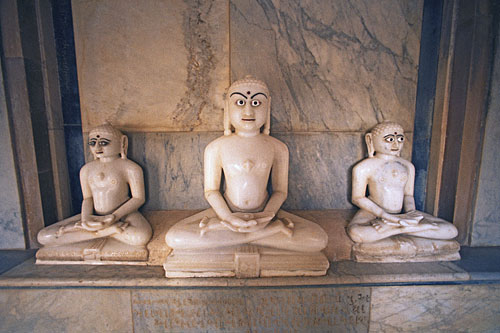History
- Jains believe that their founder, Vardhamana Mahavira (599-527 BCE) is the last of 24 holy teachers who came to teach the way of self
 mastery.
mastery. - Mahavira is not looked at exactly as a religious founder, but rather as a teacher who came to re-establish what had previously been taught
- Mahavira was a jina or “conqueror” who sought to give his followers a clear path to enlightenment
- Mahavira grew up in India where Hinduism was the dominant religion, however he was not satisfied with all aspects of the religion
- At the age of 30 he abandoned Hinduism and went to pursue his spiritual ambitions
- He became an ascetic – denying one’s self of food, clothing, and pleasure in order to achieve a higher spiritual goal
- He followed a very strict vegetarian diet, and gave up all his possessions except one piece of clothing and lead a life of intense meditation
- Meditation, the process of eliminating self-centered thinking and becoming united with the spirit that governs the universe, is one of the main spiritual practices of Jainism
- He reached enlightenment, jina, at the age of 42
- Mahavira’s life and teachings were dedicated to the art of non-violence
- He achieved “liberation” at the age of 72 when he died of gradual fasting.
Beliefs
- Jains are encouraged to follow the Five Practices:
1. non-violence (ahimsa)
2. truthfulness
3. non-stealing
4. celibacy
5. non-possession
- Jains think ahimsa is the most intelligent and most noble path to liberation and can be seen in many aspects of everyday Jain life
- This involves a commitment to all life forms on earth.
- Ahimsa has influenced many individuals and social justice movements (Ghandi, M.L.K. jr., the social justice movement)
- Jains believe in karma (every action has a consequesnce)
- Jains believe in reincarnation (an individuals eternal soul, or jiva, is reborn into different bodies over many lifetimes)
- Jains believe the goal of one’s life is to achieve moksha which is the salvation from the cycle of rebirth. This is achieved through meditation
- Jains believe that everything, including atoms, have a jiva (soul) – this connects everything on the planet and connects the physical and spiritual worlds.
- Jains believe that all truths depend on perspective and therefore there is nothing that is absolute
Milestones and Symbols
Sallekhana
- The process of gradually fasting until death
- This is considered a holy and sacred practice
- Usually only practiced by spiritually fit individuals such as monks and nuns.
- Not considered suicide, instead seen as liberation and achievement and complete separation from worldly possessions.
- Individuals die in meditation
- A person with an eating disorder is not participating in Sallekhana
Sacred Texts
- Different sects in Jainism believe in different sacred writings
- The skyclad sect believes the Satkandagama and
Kasay-aprabhrta are sacred
- The whiteclad sect believe the Āgama (tradition) is also sacred
Currently
- There are approximately 4 million Jains in the world
- Most Jains live in India, with smaller populations in Canada, the United Kingdom and the United States

Mahavira was not the founder of Jainism. There is NO official founder.